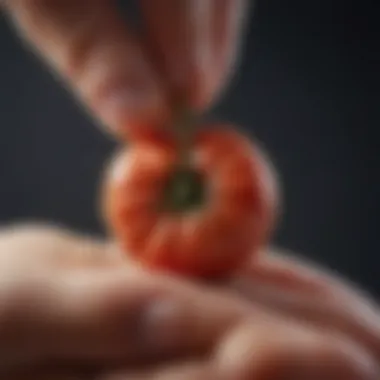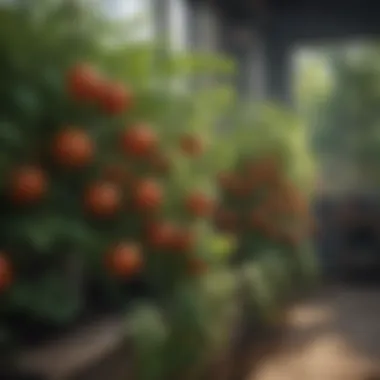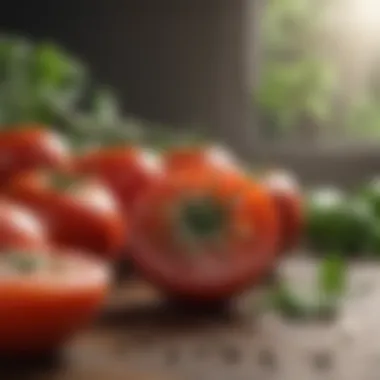Best Tomato Seeds for Thriving Gardens


Intro
Tomatoes are a staple in many gardens worldwide. Their versatility in various cuisines, combined with their nutritional profile, makes them an excellent choice for home gardeners. With numerous varieties available, choosing the right seed can seem daunting. This guide aims to simplify that decision, shedding light on the best tomato seeds for cultivation.
Understanding the specific growing conditions, such as climate, soil type, and care requirements, is crucial for selecting the right seeds. This guide also explores common challenges in tomato gardening and offers practical solutions to ensure successful growth.
As you delve into this comprehensive exploration, you will gain valuable insights to empower your gardening journey.
Intro
Growing tomatoes is a rewarding endeavor for many gardening enthusiasts. This fruit is not only a staple in kitchens worldwide but also offers a variety of flavors, colors, and textures. Choosing the right tomato seeds is crucial to success in your gardening efforts. This section discusses the importance of selecting the best tomato seeds for your garden and highlights key considerations that can influence your choice.
Tomatoes thrive in diverse climates and soil types, making them adaptable to various growing conditions. However, understanding specific varieties and their requirements can make a significant difference in final yield and flavor profile. When selecting seeds, factors such as the local climate, the amount of sunlight, and the types of soil available must all be factored in.
Additionally, different tomato varieties provide various nutritional benefits. For example, heirloom tomatoes are often praised for their rich taste and historical significance, while hybrid tomatoes tend to offer greater disease resistance and uniformity.
Understanding the specific needs and characteristics of tomato seeds can help you cultivate a successful garden. Each variety has unique growth habits and preferred conditions.
In summary, this section underscores the need to approach tomato seed selection with knowledge and care. Making informed decisions can enhance your gardening experience and lead to fruitful results. Whether you're a novice or an experienced gardener, understanding the importance of choosing the right seeds is the first step toward a bountiful harvest.
Understanding Tomato Varieties
Understanding different tomato varieties is crucial for any gardening enthusiast. Each type possesses unique characteristics, flavors, and growth patterns. Choosing the right variety can impact not only the gardening experience but also the quality and taste of the harvest. Understanding these differences helps you align your planting choices with your specific climate, soil type, and culinary preferences.
Heirloom Tomatoes
Heirloom tomatoes are celebrated for their rich flavors and diverse colors. These varieties have been passed down through generations, typically for their superior taste and adaptability. Heirloom tomatoes can vary greatly in size and shape, allowing for a unique array in the garden. They are often open-pollinated, meaning they can be saved and replanted each season without a decline in quality. However, heirloom seeds might be more susceptible to diseases compared to hybrids, which is a key consideration for gardeners facing pest challenges. The flavor profiles of heirloom varieties often surpass those of commercial hybrids, offering a more authentic taste that many find desirable in home cooking and fresh salads.
Hybrid Tomatoes
Hybrid tomatoes result from cross-breeding specific tomato varieties to enhance certain traits. These may include higher yields, disease resistance, or early maturation. They often exhibit consistent growth patterns and can adapt well to various climatic conditions. While hybrids might lack the complex flavor of some heirloom counterparts, they can be a practical choice for gardeners looking for reliability. It is essential to note that hybrid seeds cannot be saved for replanting, as they may not produce the same quality plants in subsequent generations. Through such attributes, hybrids provide an opportunity for increased productivity in the garden without compromising too much on health benefits.
Determinate vs. Indeterminate
The classification of tomato plants into determinate and indeterminate types is essential for planning your garden space and timing your harvest.
- Determinate tomatoes grow to a fixed height and produce all their fruit in a short time period. This can be beneficial for gardeners looking for a synchronized harvest, making them easier to manage. However, these plants typically do not require extensive support systems since they naturally stop growing.
- Indeterminate tomatoes, on the other hand, grow continuously until killed by frost. This variety keeps producing ripe tomatoes throughout the growing season until the frost arrives, providing a more extended harvest period. They require strong staking or cages for support as they can reach significant heights.
Understanding the difference between these types allows gardeners to make informed decisions based on available space, desired harvest frequency, and specific culinary plans. Both classifications play a significant role in achieving optimal harvest and growth conditions.
Top Tomato Varieties for Home Gardens
The selection of the right tomato varieties is crucial for any home garden. Different varieties offer unique flavors, textures, and growth habits, impacting not just the gardener's experience but also the produce quality. By understanding the best tomato varieties to grow, home gardeners can maximize their yield and enjoyment. Each variety comes with distinct needs and advantages that should align with local climate conditions and the specific garden environment. Growing the right variety can mean the difference between a bountiful harvest and a disappointing season.
Brandywine
Brandywine tomatoes are renowned for their incredible flavor. They are considered heirloom varieties, which means they have been passed down through generations and are open-pollinated. One distinct characteristic is their large, pinkish-red fruits that can weigh up to one pound. These tomatoes have a rich, sweet taste that works well in salads and sandwiches. However, growing Brandywine does require patience, as they take longer to mature than some other varieties, often taking between 80 to 100 days. Gardeners in warmer climates often find success with this variety.
San Marzano


San Marzano tomatoes are often regarded as the gold standard when it comes to cooking. Their elongated shape and lower moisture content make them perfect for sauce making. They originate from Italy and are known for their sweet and bold flavor, which enhances many recipes. San Marzano plants can thrive in moderate climates but require care when it comes to diseases like blight. Typically, these tomatoes are determinate, meaning they produce fruit over a short period, making harvest time more predictable.
Cherry Varieties
Cherry tomatoes are favored for their bite-sized goodness and versatility. Varieties such as Sweet 100 and Sungold are particularly popular due to their high sugar content, providing a burst of sweetness in every bite. These tomatoes are prolific and can be grown in a variety of settings, from traditional garden plots to containers and hanging baskets. Their fast maturation period of about 60 to 75 days makes them an excellent choice for those looking for quick results. However, caution must be exercised during the watering process, as these smaller fruits can crack easily if exposed to too much moisture.
Roma Tomatoes
Roma tomatoes, also known as paste tomatoes, are particularly valued in canning and cooking. Their thick flesh allows for less water and more meat, making them ideal for sauces and preserves. Varieties like San Marzano are considered part of this category, but others such as Roma VF are also common. Roma plants tend to be determinate and require staking to support the weight of the fruit. Gardeners should choose these varieties if their goal is to prepare and store tomatoes in various culinary forms.
Beefsteak
Beefsteak tomatoes are known for their large size and rich flavor, making them a staple in home gardens. They are perfect for slicing, making them ideal for sandwiches and burgers. Varieties like Mortgage Lifter and Big Boy are examples of beefsteak types that can weigh over a pound. Because of their size, these tomatoes may require additional support as they grow. They take longer to mature, often between 75 to 90 days, and appreciate having consistent watering and nutrient-rich soil to achieve optimal flavors.
"Choosing the right tomato variety can greatly influence your gardening success and satisfaction."
In summary, the tomato varieties you choose for your home garden should align with your taste preferences as well as your growing conditions. Understanding the specifics of each variety can enhance your gardening experience and help in selecting the best tomatoes for your culinary needs.
Factors Influencing Seed Selection
Choosing the right tomato seeds is crucial for successful cultivation. A variety of factors can significantly affect the growth and yield of tomato plants. Understanding these factors allows gardeners to make informed choices for their specific situations. This section will detail the main influences in seed selection, focusing on climate compatibility, soil type requirements, and disease resistance.
Climate Compatibility
Climate plays a major role in how well tomato seeds thrive. Each tomato variety has specific temperature and humidity needs. For example, some varieties may flourish in hot climates, while others prefer cooler conditions. Gardeners need to assess their local climate before selecting seeds. Here are some points to consider:
- Temperature Range: Tomatoes generally grow best in temperatures between 70°F and 85°F. They require warmth for seed germination.
- Frost Dates: Understanding the frost dates in your region is important as tomatoes are very sensitive to frost. Picking varieties with shorter growing seasons can yield fruits before the first frost.
- Humidity Levels: High humidity can lead to issues such as blight, while too little can stress the plants.
"Selecting tomato seeds that suit your climate can increase your chances for a successful harvest."
Soil Type Requirements
The type of soil is equally important when choosing tomato seeds. Tomatoes prefer well-drained, loamy soil that is rich in organic matter. Here are requirements to consider:
- Drainage: Heavy clay soils can retain too much water, risking root rot. On the other hand, sandy soils may not hold enough moisture.
- pH Level: Tomatoes thrive in slightly acidic to neutral soil, ideally with a pH range of 6.0 to 7.0. Testing soil pH can help determine the right amendments.
- Nutrient Content: Soil should be enriched with organic matter and appropriate nutrients. Compost and well-rotted manure can improve both fertility and structure.
Disease Resistance
Tomatoes are susceptible to various diseases that can hinder growth and yield. Selecting disease-resistant varieties is paramount for ensuring a healthy crop. Here are key aspects:
- Fungal Diseases: Common threats include blight and wilt. Certain varieties are bred specifically for resistance against these afflictions.
- Bacterial Issues: Some tomatoes are more tolerant to bacterial infections, which can be beneficial in regions prone to such diseases.
- Pest Resistance: Disease-resistant varieties often have inbuilt pest resistance, which can reduce the need for chemical treatments.
In summary, understanding the factors influencing seed selection can lead to better gardening outcomes. Keeping climate, soil, and disease resistance in mind will empower gardeners to choose the most suitable tomato seeds for their specific environments.
Cultivation Techniques
In the realm of gardening, particularly for tomato cultivation, understanding the methods of planting and nurturing your crops is essential. Cultivation techniques dictate not only the initial growth but also the overall health and productivity of the tomato plants. By carefully considering the methods employed, gardeners can maximize yield, reduce problems, and enhance the quality of their harvest. This section explores various essential techniques that are crucial for successful tomato growth.
Starting Seeds Indoors


Starting seeds indoors is a common practice among gardeners seeking to extend the growing season and ensure robust seedlings. The controlled environment of a home provides warmth and protection, which are crucial for germination. Ideally, seeds should be started about 6-8 weeks before the last expected frost date. When planting, ensure the use of quality seed-starting mix. This mix typically retains moisture while providing stability and aeration.
Every seed needs warmth to sprout, usually between 70°F and 80°F. A heat mat can help achieve this temperature. Once seeds germinate, they require ample light to prevent them from becoming leggy. Grow lights or a sunny window can facilitate this. As seedlings grow, remember to thin them out to avoid overcrowding, allowing the strongest plants to flourish further.
Transplanting Seedlings
Transplanting seedlings to the garden requires careful timing and technique to ensure a smooth transition. It is important to wait for the last frost threat to pass and to ensure the soil warms up adequately, usually around 60°F or above. A week or so before transplanting, consider hardening off the seedlings. This process involves placing them outside for a few hours each day to acclimate them to the outdoor environment.
When transplanting, select a cloudy day or the late afternoon to minimize stress on the plants. Dig a hole that accommodates the root ball, and gently remove the seedling from its container. Ensure the soil is well-prepared, adding compost if necessary for added nutrients. Place the plant in the hole at its original soil level, and water thoroughly to eliminate air pockets.
Soil Enrichment and Amendments
Soil plays a critical role in the success of tomato cultivation. Healthy, nutrient-rich soil supports robust growth and fruit production. Begin with a soil test to determine its pH, nutrient levels, and overall fertility. Ideal pH for tomatoes is between 6.0 and 6.8. Depending on the test results, you may need to adjust the soil structure.
Adding organic matter such as compost or well-rotted manure helps improve soil structure, water retention, and nutrient availability. It is beneficial to mix in amendments like bone meal or fish emulsion to provide essential nutrients such as phosphorus, which promotes root development and flowering.
"Healthy soil means healthy tomatoes. Focus on nurturing the ground they grow in."
Overall, understanding and applying effective cultivation techniques is essential for anyone interested in growing tomatoes. Through proper starting methods, careful transplanting, and enriching the soil, gardeners can foster a thriving tomato crop that rewards them with bountiful harvests.
Watering and Maintenance
Effective watering and maintenance are crucial components of successful tomato cultivation. Proper hydration directly influences the health of the plants and the quality of the tomatoes produced. Watering strategies must be adapted based on the tomato variety, soil type, and local climate conditions. Additionally, regular maintenance tasks like mulching and pruning contribute significantly to the overall productivity and health of the garden.
Irrigation Techniques
Using the right irrigation techniques ensures that your tomato plants receive adequate moisture without over or under watering. Here are a few common methods:
- Drip Irrigation: This method delivers water directly to the soil at the plant's root level, minimizing evaporation and water wastage. It encourages deep root growth, which is essential for nutrient uptake.
- Soaker Hoses: Like drip irrigation, soaker hoses allow water to seep slowly into the soil. They are easier to manage in smaller gardens and save time compared to traditional watering methods.
- Sprinklers: While effective for larger areas, they may lead to water on the foliage, which can cause fungal diseases. Adjust settings to ensure minimal foliage exposure.
Control the frequency of watering based on the weather. In hotter months, plants may need daily watering, particularly if there is little rainfall. Monitor the soil moisture by checking its level; it should be consistently moist but not soggy.
Mulching Strategies
Mulching serves many purposes in tomato cultivation, from moisture retention to weed suppression. Here are some effective mulching strategies:
- Organic Mulch: Using straw, wood chips, or grass clippings can improve soil fertility as the material breaks down. Organic options also discourage weed growth.
- Plastic Mulch: Black plastic not only retains moisture but also warms the soil, which can benefit early-season growth. However, it does not enhance soil quality over time.
- Living Mulch: Planting cover crops or low-growing plants around tomato plants can provide nutrients and prevent soil erosion. These plants naturally suppress weeds.
Each type of mulch provides unique benefits, so choose based on your gardening style and soil needs. Adequate mulching can significantly reduce the time spent on watering.
Pruning and Support Systems
Pruning is essential in managing tomato plants to improve air circulation, sunlight penetration, and fruit quality. Here are some key points to consider:
- Remove Suckers: These are small shoots that grow between the main stem and branches. By removing them, the plant can focus its energy on producing fruit.
- Thin the Leaves: Trimming excess foliage helps in air circulation, which reduces the risk of fungal diseases.
Support systems also play an important role. Using cages, stakes, or trellises keeps plants upright, allowing for better sunlight exposure and easier access for maintenance and harvesting.
Effective pruning and proper support systems can lead to higher yields and healthier plants. By managing the physical structure of your tomato plants, you can maximize their growth potential.


In summary, the principles of watering, mulching, and pruning contribute significantly to the successful growing of tomatoes. Proper attention to these aspects will not only enhance the health of the plants but also improve the overall yield of your garden.
Harvesting and Storage
Harvesting and storage are critical aspects of tomato cultivation that can greatly affect both the quality and shelf life of your produce. Understanding when and how to properly harvest tomatoes ensures that the fruits retain their best flavor and nutritional values. Additionally, effective storage prevents spoilage and maintains the quality of the tomatoes for extended periods. A gardener must pay attention to both factors to achieve successful outcomes in their gardening efforts.
When to Harvest
Knowing the right time to harvest tomatoes is essential for obtaining the best taste and texture. Color is one of the primary indicators of readiness. Varieties like Brandywine and San Marzano will display deep, rich colors when fully ripe. For most tomatoes, like Roma and Cherry, you should wait until they are fully colored, as this often signifies peak ripeness.
It's also advisable to conduct a tactile test. Gently squeeze the tomato; a ripe one will yield slightly to pressure. If the fruit remains hard, it should be left on the vine for a few more days.
Cultivating attention to the leaves is also important. The leaves will often start to yellow as the fruits approach ripeness, which may indicate that it's time for harvest.
Lastly, consider the climate; if you expect a frost, it's wise to harvest earlier, even if the tomatoes are not fully ripe. Protecting your crop is paramount.
Storing Tomatoes Properly
Proper storage techniques always ensure that harvested tomatoes retain their quality and flavor. The best practice is to store ripe tomatoes at room temperature. Storing them in a cool, dry area away from direct sunlight helps to preserve their taste. It's essential not to refrigerate tomatoes unless they are overly ripe and you are concerned about spoilage. Refrigeration can alter the texture and flavor, rendering them mealy and less palatable.
When you need to store tomatoes for longer, consider canning or making sauces. Both methods significantly extend the shelf life of fresh tomatoes. If you require using tomatoes in the next few weeks and they are starting to overripe, you can dry them or freeze them. Dehydrating tomatoes intensifies their flavors and can make excellent additions to various dishes.
Storing tomatoes correctly not only helps in sustaining their nutritional benefits but also enhances your overall gardening experience. Good practices in harvesting and storage lead to greater satisfaction in enjoying the fruits of your labor.
Common Challenges in Tomato Cultivation
Understanding common challenges in tomato cultivation is crucial for any gardener aiming for a successful yield. Growing tomatoes can be rewarding, but numerous obstacles can arise. These include pests, diseases, environmental issues, and cultural practices that may hinder growth. Addressing these challenges allows gardeners to maximize their harvest and enjoy a healthy, productive garden.
Pest Management
Pests can severely impact tomato plants. Common pests include aphids, tomato hornworms, whiteflies, and spider mites. These insects not only feed on the plants but can also introduce diseases. Effective pest management starts with preventive measures. Regularly inspecting plants for signs of infestations is essential. Introduce beneficial insects like ladybugs and lacewings, which prey on harmful pests. Additionally, using physical barriers such as row covers can protect young plants.
Another method is the use of organic insecticidal soaps or neem oil as a treatment option. These products often target pests specifically without harming beneficial insects. Keep in mind that timing is critical. Applying treatments during the early stages of infestation prevents larger outbreaks. Regular monitoring and swift action can ensure healthier plants and a bountiful harvest.
Managing Plant Diseases
Diseases can also threaten the vitality of tomato plants. Among the most common are early blight, blight, and Fusarium wilt. These conditions may arise due to factors like overcrowding, poor drainage, or insufficient sunlight. Understanding the symptoms is key. Early blight, for instance, shows as dark spots on older leaves, leading to defoliation if left unchecked.
Preventing diseases begins with good cultural practices. Ensure proper spacing between plants to improve air circulation and decrease humidity around the foliage. Regular crop rotation can also mitigate problems since many pathogens remain in the soil from previous crops. Select disease-resistant varieties where possible, as these are better equipped to handle specific threats.
In the occurrence of disease, removing affected plant parts immediately is vital to prevent further spread. Additionally, using fungicides, if needed, can assist in managing outbreaks. Knowledge about disease life cycles will empower gardeners to take informed measures.
Throughout the growing season, a proactive approach to both pest and disease management can significantly enhance the gardening experience, yielding healthy and productive tomato plants.
End
The conclusion serves as a crucial component in any comprehensive guide, summarizing key insights while reinforcing the significance of the discussed elements. In the context of this article, it encapsulates the essence of selecting the best tomato seeds for cultivation, a topic that resonates with both novice and experienced gardeners.
Selecting tomato seeds is not merely about variety preference; it involves a nuanced understanding of the growing conditions and desired outcomes. Thus, the decision-making process we outlined should empower readers to make informed choices. Here are some specific benefits and considerations that we have explored:
- Understanding Varieties: Each tomato variety possesses unique traits, from taste to growth habits. By grasping these differences, gardeners can align their choices with personal gardening goals.
- Growing Conditions: Factors like climate compatibility and soil type significantly impact the success of plants. Recognizing the importance of these elements can lead to thriving gardens and bountiful harvests.
- Cultivation Techniques: Practical skills in seed starting, transplanting, and maintaining plants offer gardeners the tools needed to address common challenges. This knowledge enhances confidence in gardening practices.
- Common Challenges: Identifying threats from pests and diseases is essential for preventing losses. The strategies discussed in the article provide effective management techniques that can lead to healthier plants.
Moreover, this guide underscores the importance of adaptive gardening — being flexible and responsive to changing conditions is key. The incorporation of crop diversity allows for a more resilient garden. As you reflect on these insights, consider how they can improve your own gardening journey.
By cultivating a deeper understanding of tomato seed selection and care, readers are better equipped to enjoy the benefits of home gardening. The knowledge shared here is not just about growing tomatoes; it's about fostering a meaningful connection with gardening itself. Ultimately, the insights provided will facilitate a richer vegetable gardening experience, leading to informed decisions that can enhance overall outcomes.















